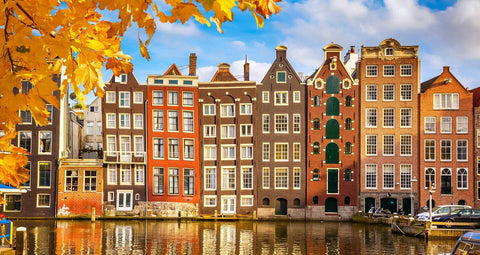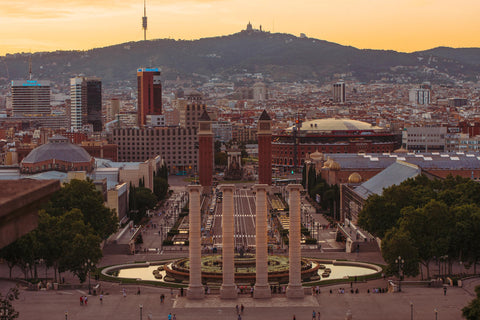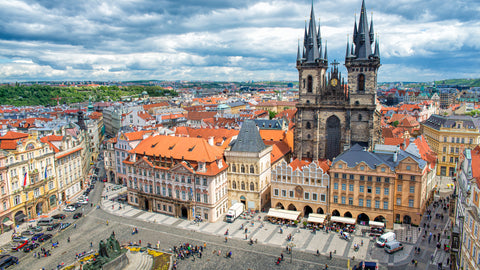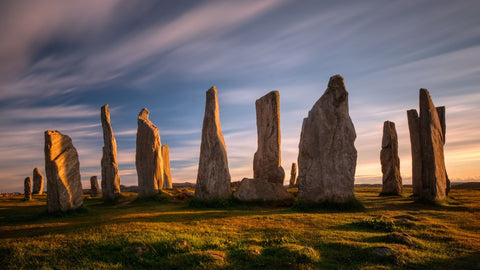1. Amsterdam, Netherlands

Amsterdam is a city that has something for everyone. Whether you are into art, history, architecture, nightlife, or nature, you will find plenty of attractions and activities to suit your interests. Amsterdam is also a very friendly and welcoming city, with a tolerant and multicultural atmosphere. You will have no problem meeting new people and making friends, as the locals are generally fluent in English and eager to help. Amsterdam is also a very safe and easy city to navigate, with an efficient public transport system and a network of bike lanes. You can rent a bike and explore the city like a local, or hop on a tram, bus, or metro to get around.
What to See and Do?
Amsterdam has so many things to see and do that you might feel overwhelmed by the choices. Here are some of the must-see and must-do attractions and activities that I recommend for solo travellers:
- Visit the Anne Frank House, where you can learn about the life and diary of the young Jewish girl who hid from the Nazis during World War II. This is a very moving and educational experience, but be prepared to queue for a long time, as this is one of the most popular attractions in Amsterdam. You can book your tickets online in advance to avoid the lines.
- Explore the Rijksmuseum, the largest and most prestigious museum in the Netherlands, where you can admire the works of famous Dutch artists such as Rembrandt, Vermeer, and Van Gogh. The museum also showcases the history and culture of the Netherlands, from the Middle Ages to the present day. You can easily spend a whole day here, so plan your visit accordingly.
- Enjoy the canals, the iconic feature of Amsterdam that gives the city its charm and character. You can take a boat tour and cruise along the waterways, admiring the picturesque bridges and houses. You can also walk or bike along the canal banks, stopping at cafes, shops, and markets along the way. You can also visit some of the canal houses that have been turned into museums, such as the Museum Van Loon or the Museum Willet-Holthuysen.
- Discover the countryside, which is a short and easy trip from Amsterdam. You can take a train or a bus to some of the nearby towns and villages, where you can see the traditional Dutch landscape of windmills, tulips, and cheese. You can also rent a bike and cycle through the fields and farms, enjoying the fresh air and scenery.
2. Barcelona, Spain

Barcelona is a city that combines history, culture, and modernity in a captivating way. It is the capital of Catalonia, a region with its own language, identity, and traditions. Barcelona is also a major Mediterranean port and a hub of innovation and creativity. Whether you are interested in art, architecture, cuisine, or nightlife, you will find plenty to enjoy and discover in this vibrant and diverse city.
Some of the things that you should not miss when visiting Barcelona are:
- Sagrada Família, the masterpiece of Antoni Gaudí, the most famous architect of Catalan Modernism. This basilica, which has been under construction since 1882, is a stunning example of organic and symbolic design, inspired by nature and Christian faith. You can admire the intricate facades, the soaring towers, and the colorful stained glass windows, as well as visit the museum and the crypt.
- Park Güell, another creation of Gaudí, this park is a whimsical and enchanting place, where you can see his distinctive style of mosaic, sculpture, and architecture. You can walk around the gardens, the monumental zone, and the Gaudí House Museum, where he lived for some years.
- La Rambla, the most famous street in Barcelona, a lively and bustling boulevard that runs from Plaça de Catalunya to the port. You can stroll along the pedestrian area, where you can see street performers, artists, flower stalls, and the iconic Boqueria market. You can also visit some of the attractions along the way, such as the Liceu opera house, the Palau de la Virreina, and the Columbus monument.
- Gothic Quarter, the oldest part of the city, where you can explore the narrow streets and squares that preserve the medieval charm and history of Barcelona. You can see some of the landmarks, such as the Cathedral, the City Hall, the Palace of the Generalitat, and the Basilica of Santa Maria del Mar. You can also enjoy the atmosphere of the bars, restaurants, and shops that fill the area.
3. Prague, Czech Republic

Prague is the capital and largest city of the Czech Republic and the historical capital of Bohemia. It is one of the most beautiful and cultural cities in Europe, with a rich architectural heritage that spans from the Romanesque to the modern era. Prague is also known as the “city of a hundred spires” for its many church towers that dot the skyline. Prague is situated on the banks of the Vltava River, which offers scenic views and bridges, such as the famous Charles Bridge. Prague is a city that will enchant you with its charm, history, and art.
Some of the things that you should not miss when visiting Prague are:
- Prague Castle, the largest ancient castle in the world, where you can see the impressive St. Vitus Cathedral, the Royal Palace, the Golden Lane, and the gardens. You can also enjoy the changing of the guard ceremony and the panoramic views of the city from the castle hill.
- Old Town Square, the heart of the historical center of Prague, where you can admire the Gothic Church of Our Lady before Týn, the Baroque St. Nicholas Church, the Rococo Kinský Palace, and the Old Town Hall with its famous astronomical clock, which displays a show of moving figures every hour.
- Jewish Quarter, the former ghetto of Prague, where you can visit the Old-New Synagogue, the oldest active synagogue in Europe, the Jewish Museum, which displays the history and culture of the Jewish community in Prague, and the Old Jewish Cemetery, where thousands of gravestones are piled on top of each other.
- Petřín Hill, a green oasis in the city, where you can take a funicular ride or hike to the top, where you can see the Petřín Tower, a smaller version of the Eiffel Tower, and the Mirror Maze, a fun attraction with distorted mirrors. You can also enjoy the rose garden, the observatory, and the stunning views of the city.
- Wenceslas Square, the main boulevard of Prague, where you can see the National Museum, the statue of St. Wenceslas, the patron saint of Bohemia, and the site of many historical events, such as the Velvet Revolution of 1989. You can also shop, dine, and party in the many stores, restaurants, and clubs that line the square.
4. Berlin, Germany

Berlin is the capital and largest city of Germany, both by area and by population. It is a city that has witnessed and shaped many historical events, from the rise and fall of the Prussian kingdom, the German Empire, the Weimar Republic, and Nazi Germany, to the division and reunification of Germany after World War II. Berlin is also a city that celebrates its diversity, creativity, and culture, with a vibrant and cosmopolitan atmosphere. Berlin offers a rich and varied array of attractions and activities for visitors, from museums and monuments, to parks and gardens, to nightlife and festivals.
Some of the things that you should not miss when visiting Berlin are:
- The Brandenburg Gate, the iconic symbol of Berlin and Germany, which stands at the end of the Unter den Linden boulevard. The gate was built in the 18th century as a sign of peace and was later the site of many historical events, such as Napoleon’s entry, Hitler’s parades, and the fall of the Berlin Wall. The gate is also the location of the famous Quadriga, a sculpture of a chariot pulled by four horses, which was taken by Napoleon and later returned by the Prussians.
- The Reichstag, the seat of the German parliament, which is a striking example of the fusion of old and new architecture. The original building, which was completed in 1894, was severely damaged by fire and war, and was restored and modernized in the 1990s by the British architect Norman Foster. The most notable feature of the new design is the glass dome, which offers a panoramic view of the city and the parliamentary chamber. Visitors can also access the roof terrace and the dome, as well as join a guided tour of the building.
- The Museum Island, a UNESCO World Heritage Site, which is a complex of five museums located on an island in the Spree river. The museums are the Pergamon Museum, which houses ancient and Islamic art, the Bode Museum, which displays Byzantine and medieval art, the Old National Gallery, which showcases 19th-century German and European art, the Old Museum, which exhibits classical antiquities, and the New Museum, which contains Egyptian and prehistoric collections. The Museum Island is also home to the Berlin Cathedral, a majestic neo-Renaissance church.
- The East Side Gallery, a 1.3-kilometer (0.8-mile) section of the Berlin Wall, which is the longest surviving part of the former barrier that divided the city. The wall was painted by more than 100 artists from different countries in 1990, after the fall of communism, and features colorful and expressive murals that reflect the themes of freedom, peace, and hope. The East Side Gallery is also a memorial and a reminder of the history and the changes that Berlin has undergone.
- The Tiergarten, the largest and oldest park in Berlin, which covers an area of 210 hectares (520 acres). The park was originally a hunting ground for the Prussian kings, and was later transformed into a public park in the 18th century. The park offers a green and relaxing space for visitors, with many paths, ponds, statues, and monuments. Some of the attractions in the park are the Victory Column, a 67-meter (220-foot) high tower topped by a golden angel, the Bellevue Palace, the official residence of the German president, and the Berlin Zoo, the oldest and most visited zoo in Germany.
5. Edinburgh, Scotland

Edinburgh is the capital city of Scotland and one of the most historic and cultural cities in the UK. It is famous for its stunning medieval and Georgian architecture, its majestic castle, and its lively festivals and events. Edinburgh is also a UNESCO World Heritage Site, with two distinct areas: the Old Town, which dates back to the 12th century, and the New Town, which was built in the 18th century. Edinburgh is a city that offers a rich and varied experience for visitors, from history and heritage, to art and literature, to nature and adventure.
Some of the things that you should not miss when visiting Edinburgh are:
- Edinburgh Castle, the most iconic landmark of the city, which sits on a volcanic rock overlooking the city. The castle is home to the Scottish Crown Jewels, the Stone of Destiny, the National War Museum, and the One O’Clock Gun. You can explore the castle grounds, take a guided tour, or watch the spectacular Military Tattoo in August.
- The Royal Mile, the main street of the Old Town, which runs from the castle to the Palace of Holyroodhouse, the official residence of the Queen in Scotland. The Royal Mile is lined with historic buildings, museums, churches, shops, and pubs. You can see the St Giles’ Cathedral, the Heart of Midlothian, the Scottish Parliament, and the Museum of Edinburgh, among others.
- The National Museum of Scotland, the largest and most popular museum in the country, which showcases the history, culture, and natural wonders of Scotland and the world. The museum has over 20,000 objects on display, covering topics such as archaeology, art, science, technology, and fashion. You can also enjoy the rooftop terrace, which offers a panoramic view of the city.
- Arthur’s Seat, the highest point of Holyrood Park, which is a large green space in the east of the city. Arthur’s Seat is an ancient volcano that rises 251 meters above sea level and offers stunning views of the city and the surrounding countryside. You can hike to the summit, or follow one of the many trails in the park. You can also visit the ruins of St Anthony’s Chapel, the Duddingston Loch, and the Salisbury Crags.
- The Edinburgh Festival Fringe, the largest arts festival in the world, which takes place every August in various venues across the city. The festival features thousands of performances of comedy, theatre, music, dance, and more, by both professional and amateur artists. The festival also includes street performers, markets, and fireworks. You can find something for every taste and budget, but be sure to book your tickets and accommodation in advance, as the city gets very busy during this time.
Conclusion
Traveling solo in Europe offers an array of experiences, from cultural and historical to natural wonders. With Europe eSim, you can ensure that you're always connected, making your journey safer and more enjoyable. Whether you're into history, culture, or natural beauty, Europe has something to offer every solo traveler.














